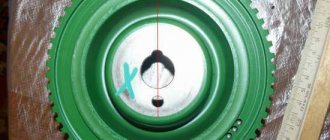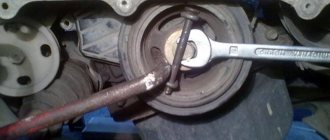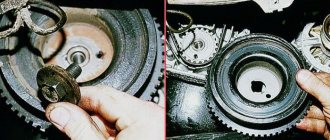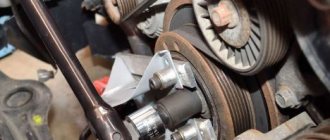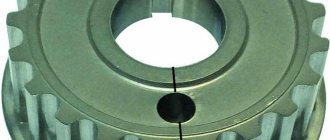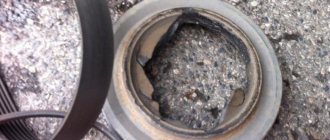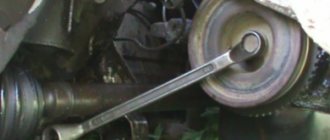02/28/2022 24,964 VAZ 2114
Author: Ivan Baranov
Often, when repairing a car, it is necessary to remove the crankshaft pulley of a VAZ 2114. An experienced motorist completes this operation in a quarter of an hour, but a beginner sometimes encounters many problems during removal. The article provides detailed instructions on how to remove the crankshaft pulley of a VAZ 2114, as well as a video in which you can see the removal process.
[Hide]
What problems might you encounter?
There is a possibility that you may not immediately notice the characteristic disc part under the hood of your car. It may also be difficult to access. It will be difficult to fix the shaft. Over a long period of time, the joints of fasteners will “stick” and you will have to use special liquids.
Related article: How to replace a timing chain in a garage
To perform all the necessary steps step by step, you will need the following tools:
- impact wrench;
- puller set;
- jack;
- a set of wrenches or other tools for removing bolts;
- presence of an inspection hole.
Installation
1. Thoroughly clean the piston from carbon and deposits. We inspect the piston and connecting rod. Cracks on them are unacceptable.
2. We select new rings in accordance with the diameter of the piston - nominal or repair size. There are no markings on the nominal size rings; the repair rings are increased in diameter by 0.4 or 0.8 mm, and are marked “40” and “80”, respectively.
3. Before installing new rings, use a set of feeler gauges to measure the gap between the piston ring and the wall of the groove in which the ring will be installed.
If the gap exceeds the maximum allowable, the piston must be replaced.
Table 8.1.4. Permissible clearances between groove walls and piston rings
| Ring | Gap, mm |
| Upper compression ring | 0,04-0,07 |
| Bottom compression ring | 0,03-0,06 |
| Oil scraper ring | 0,02-0,05 |
Oil scraper ring.
. and install the upper compression ring with the words “VAZ” or “TOR” facing up.
We orient the lower compression ring so that its groove is directed downwards.
4. We put the rings on the piston as follows: having spread the ring lock (no more than is required to put the ring on the piston), we first place the lock on the piston, and then the back part of the ring.
We install new rings on the piston, starting with the oil ring expander. After installing the oil scraper ring, the expander lock should be rotated 180° relative to the ring lock.
After installing the rings on the piston, we rotate them with locks so that the lock of the upper compression ring is located at an angle of 45° to the piston pin axis, the lock of the lower compression ring is rotated 180°, and the lock of the oil ring is 90° relative to the lock of the upper compression ring.
What is needed to remove the crankshaft pulley?
If you open the manual for the technical operation of the machine, the repair procedure is described briefly, and the algorithm itself is simple and easy to implement. But this is at first glance. In practice, the work takes a lot of time. There are a number of difficulties worth highlighting here.
The pulley is located in the engine compartment, where not every element has access. As a rule, the necessary part is “hidden” behind the generator and body parts. To gain access to the assembly, it is often necessary to loosen the tension bolts, as well as dismantle the power steering and generator belts. But even after this, removing the crankshaft pulley takes a lot of time.
The part of interest is fixed (at the factory) using a nut or bolt. In this case, broaching occurs with maximum torque (to ensure tight fixation). During subsequent operation, the nut is tightened even more.
In addition, the influence of environmental factors and elevated temperatures lead to the appearance of rust and coking of the oil. As a result, the bolt or retaining nut literally “sticks” to the pulley housing. At the same time, it is not always possible to “rip off” a part the first time.
Before unscrewing the crankshaft pulley bolt, it is worth understanding the fixation of the pulley itself on the crankshaft. Otherwise, you will not be able to unscrew the nut. Special devices are used in the service, but in a garage it is enough to put supports under the wheels and move the gearshift lever to the fourth speed position. Another option is to fix the flywheel by resting on its holes or the toothed part of the mount.
Purpose, where they are located
Half rings or crescents, washers - they are called differently, they have a special purpose. They keep the crankshaft from axial displacement or longitudinal play. Essentially, these are special type bearings that establish the required clearance.
In a classic 4-cylinder engine, the crankshaft has a minimum of 5 bearing points or journals. Their contact area is quite large. This increases the friction force, which becomes even greater when the cheeks touch the supports. To minimize structural imbalance, the necks are made wider than the supports. But such a solution causes longitudinal play, which is a priori unacceptable, since the crankshaft parts begin to fail prematurely as a result.
Metal stoppers in the shape of a crescent are precisely the most effective solution that allows you to maintain the classic design, while eliminating axial displacement. This bearing differs from the standard liner in the presence of side stops or shoulders. The surfaces of the areas where the crankshaft comes into contact with them are also modified. In particular, they are made to fit a ring.
To reduce longitudinal play, washers are also suitable - one-piece rings that are installed strictly in a place specially designed for them. However, such locking elements are rarely used, since lock bearings adhere more tightly to surfaces, wear out more evenly, and are easier to install and remove. And the most important thing is that the washer is installed only on the rear main journal, and the crescents can be placed on any journal.
Structurally, the locking element is very simple. The base is made of solid bronze or steel material, on which, in some cases, an anti-friction protective layer is applied. There must be grooves or recesses for free passage of lubricant, as well as special pins that enhance fixation.
Thrust half rings are placed between the block support and the crankshaft brushes. Here they keep it from axial movement and play to the maximum extent possible. Installed on various necks. For example, in the VAZ-2106 - on the 5th main bearing, which is the first on the flywheel side. In general, according to this scheme:
- anterior - on the third or one of the central necks;
- posterior - on the back neck.
Either 2 or 4 half rings are used. If two are used, then they are placed in the recesses of the lower yoke cover. And if there are four - an upper support and a removable yoke (like on tractor engines). There are also power units with one crankshaft locking crescent or just a washer.
How to remove the crankshaft pulley?
Once you have dealt with the potential difficulties of dismantling, you can get to work. As a rule, the pulley is secured using a nut (on rear-wheel drive vehicles) or a bolt. The biggest problems arise with the first fastening option.
The crankshaft pulley is secured with a nut. The mounting nuts are often designed with lifts to allow them to engage the “ratchet.” In service conditions, craftsmen use “thirty-eight” or “thirty-six” socket wrenches. To speed up the twisting process, an elongated handle and a special fixing device are used, which is placed on the pulley. But how to unscrew the crankshaft pulley when there is no access to a special tool?
In such a situation, proceed as follows:
- Drive the car to a suitable place (this could be an overpass or a pit).
- Move the gearshift knob to the fourth speed position (provides fixation of the crankshaft).
- Raise the handbrake to its extreme position (to avoid accidental movement of the car).
- Take a socket wrench (matching the size of the fastening nut), install an additional “elbow” (a metal pipe will do), and then try to tear off the bolt. Many people ask the question in which direction to unscrew the crankshaft pulley bolt. Here the answer is clear - only counterclockwise.
Recommendations
Comments 20
When cleaning the oil channels, did you remove the plugs from there?
Do you mean on the crankshaft after processing? I don’t know, it’s unlikely, they probably just blew it out with air. After I picked it up I didn’t do anything with it, I installed it right away
There, a transitional drilling from one neck to another is made through the cheek, and the inlet hole is clogged with a ball, which even has a number in the catalog. Apparently, this means picking it out when cleaning it and installing a new one.
No, these balls were not touched. I don’t think that a lot of “manure” has accumulated under them))) Well, what the heck, they’re pressed in there, you can’t get them out, and then the new ones, God forbid, don’t press in properly and pop out during operation
Above all praise! I give you a standing ovation!
Well done, a lot of work has been done. Congratulations! I didn’t remove the engine, but the floor of the engine was scattered and the gearbox had to be thrown off, this is also not easy. And lubricant for high-speed bearings on the splines is barbaric))) it could have been done with ordinary lithol))) And the question is that the nanogasket was made only on one half ring?
After all that has been done, I would probably still advise removing the engine))) Still, you need to work with the crankshaft when the engine is upside down. But it would not be easy to move it back and forth even if it was removed, especially if there is no tilter and there is no one to help. Yes, and how to remove it up? I don’t have a hook in the ceiling or anything else)))
Well done, a lot of work has been done. Congratulations! I didn’t remove the engine, but the floor of the engine was scattered and the gearbox had to be thrown off, this is also not easy. And lubricant for high-speed bearings on the splines is barbaric))) it could have been done with ordinary lithol))) And the question is that the nanogasket was made only on one half ring?
Yes, this Blue lubricant is, in principle, lithol, only more stable, so it definitely won’t be worse. I only placed a gasket under one half ring. And it would be more logical to put it under the half-ring where the layer of metal was removed on the crankshaft, but I was afraid to put it under the loaded half-ring
I couldn’t get the crankshaft pulley off, what should I do?
If you succeed in breaking the fastening, unscrewing the nut completely is not difficult. But this doesn't always happen. In case of negative circumstances, use a different technique:
- Put the car in neutral.
- Remove the caps (installed on the spark plugs). This is done to avoid accidental starting of the motor.
- Throw the wrench onto the pulley nut, then press the edge of the lever into the spar (ground). The main goal in this case is to prevent the pulley from spinning.
- Turn the starter briefly to give the required impulse. Typically, one or two turns is enough to remove the nut. Then you can continue working using the key.
see also
Comments 27
The procedure for replacing the crankshaft without removing the engine is 99% completely feasible when working by one person. Short-term help is only needed to remove and install the gearbox and carefully install the camshaft. You can easily remove the old distributor by yourself. I installed one, but then I need to lay clean material on the beam and make a hanger for the back of the stake. I installed all the main liners in the block, and prepared 1 and 4 main caps with liners. Then I lubricated everything with oil, first the crankshaft was placed on the beam with counterweights horizontally, it was intercepted, then the rear journal was in the suspension and the front journal was in the seat. Then for a few seconds you need to press the shaft weighing 14.5 kg upward onto the seats with one hand and install 1 main cover in place. Then, without letting go, grab and post the 4th lid. This is the hardest thing. If anyone can help for a minute, the installation will be no problem at all. The advantages of this procedure: - no need to invent a procedure for removing the engine - the cooling system, cylinder head, camshaft, piston, carburetor, distributor, attachments, electrical wiring are also not affected. Even the adjusted ignition will not go astray if you mark the location of the oil pump drive sprocket before loosening the chain.
Cons - oil drips for some time (as already mentioned here), but in insignificant quantities
It’s not the crankshaft that’s knocking... In general, it’s not clear what it is. Replaced: Crankshaft + liners Piston + rings + pins Camshaft with housing + rocker with adjusting bolts Chain, sprockets, shoe, damper Piglet + fungus Compression is a beast, the finger is sucked into the breather tube...
I tried it like in this video, I pump it sharply and there seems to be something knocking in the fourth cylinder. But you can't feel anything with a screwdriver through the spark plug hole.
So, friends, the end of the story with the crankshaft. Last time I wrote how I removed it and showed the wear on one surface under the thrust semi-ring. The crankshaft was taken for grinding of this surface. To get the groove out clean, I had to grind as much as 0.5 mm! Grinding + polishing + washing the crankshaft cost me 615 rubles and 3 days of waiting. I can recommend it to anyone from Voronezh, they have quite good machines and the staff seems competent)))
Necessary tool
When disassembling an engine or partially replacing its components, it is often necessary to unscrew this element. Rare dismantling of this unit leads to the fact that over time the fastening bolt turns sour. In such a situation, you can decide on one of the ways to unscrew the fastener. To carry out the work you will need a set of tools.
Quick removal of the VAZ 2114 crankshaft pulley is only possible if you have the following tools:
- Jack for raising the car;
- Wheel chocks (bricks, boards, etc.) for securely securing the vehicle;
- Mount as a lever;
- Set of keys and heads: 17, 19, 13 and 10.
It is better to carry out dismantling work on a lift or pit. If this is not possible, ensure that the vehicle is supported by one jack. In addition to the set of tools listed, a lubricant such as WD-40 will not be superfluous. When you start work, treat the fastening and after 10-15 minutes proceed with removal.
Dismantling may be necessary when replacing the timing belt or oil seal. Such work cannot be done without removing this part. Rarely does a pulley need to be replaced. Even though this part is made of metal, it also deforms over time, causing problems with the crankshaft position sensor.
There are quite a few options for unscrewing the pulley, but in this article we will look at three main methods of dismantling.
Functionality check
If you decide to check the serviceability of the sensor yourself, treat this procedure responsibly and carry it out correctly. On a VAZ 2114 car, the crankshaft sensor is checked in several ways.
- Using a multimeter. The serviceability of the induction sensor can be assessed by the resistance of its coil. In a working product it is 500-700 Ohms.
- On the multimeter, set the measurement limit to 200 millivolts, connect the probes to the terminals (where the standard wires are connected). Pass a steel object several times in front of the core. The working sensor will “see” the metal and there will be voltage spikes on the multimeter display. If there are none, replace the part.
- But the most accurate results when checking are provided by an oscilloscope. When using this device, one hundred percent results can be guaranteed; it reads all the information from the sensor while the engine is running. It can be observed on the device screen. The engine, during tests, should operate at different speeds. They start with eight hundred revolutions, then two thousand, and raise it to six thousand. If the lines (on the device screen) are of different lengths, you need to look for the cause of the malfunction. Remove dirt, check the pulley for defects, and so on.
Method 1
The first step is to try to remove the pulley bolt using the standard method. The set of tools for this procedure is as follows: heads, spanners, jack. The step-by-step removal process looks like this:
- Unscrew the right wheel and jack up the car;
- Remove the plastic protection (if any);
- Loosen the generator belt tension bolt and remove it;
- Reach the pulley and lock it in one position;
- Remove the timing belt;
- Place a socket or a 19mm spanner on the pulley nut and try to tear it off;
- If the fastening does not work, treat the nut with WD-40 or tap the pulley with a wooden block. Often this allows you to get rid of sticking.
Method 2
If you can’t remove the nut with a regular wrench, don’t torture yourself and use an additional lever. Often in spare parts stores you can find keys with a long lever. This kind of tool is just right for this kind of work. If you do not have such a device at hand, you can use a metal pipe.
The step-by-step process using the lever is similar to the previous instructions:
- Remove the alternator belt;
- Place the car on a jack;
- Remove the timing belt;
- Using a pipe of suitable diameter, place it on the ratchet or wrench, then press firmly on it;
- Due to the inconvenient location of the pulley, extension cords should be used during operation.
The nut breaks counterclockwise, so do not strip the thread when trying to unscrew it in the opposite direction.
Together with treatment with a chemical lubricant, this method allows you to quickly unscrew the fastener. Understanding how to unscrew the crankshaft pulley bolt greatly simplifies the process of replacing the timing belt or oil seal. Note that the above methods for removing the VAZ 2114 crankshaft pulley (8 valves) are used in professional services. The only thing that can additionally be used to remove a part in a service station is a pneumatic tool. Next, we will consider another effective method of dismantling a part.
Replacing the front oil seal on a VAZ 2113-VAZ 2115
Note! Before replacing the oil seal, make sure that the problem is there and not caused by the crankcase ventilation system. It’s just that this system becomes dirty over time and oil begins to be squeezed out through the seals. We recommend that you read more about this topic in the article: “Cleaning the crankcase gas system on a VAZ 2114.”
Removal
First, you need to remove the timing belt from the pulleys (for instructions, see the publication: “Replacing the timing belt on VAZ vehicles”). Then, using two small screwdrivers, carefully pry off the crankshaft toothed pulley (photo 1). Behind you will find an oil seal; just pry it out with a screwdriver and remove it from its seat (photo 3). However, there is a metal key on the crankshaft (photo 2, indicated by the arrow). It is advisable to carefully pry it with a screwdriver and remove it, or make sure that it does not fall and get lost. The key keeps the pulley from turning; the part is important, so if you lose it, go to the auto store for a new part.)
Installation
The main thing is to lubricate the oil seal with the engine oil currently poured into the car engine. It is not the entire oil seal that needs to be lubricated, but only the working edge - the place where the oil seal sits on the shaft. Then take a small piece of pipe or a union head of a suitable diameter and, with their help, the oil seal is pressed inside (photo 4). After installation, thread the oil seal with a thin, but not too sharp, pencil. Check whether the part is installed well.
Note! During installation, do not make the wrong side, otherwise the seal will leak. The oil seal has a front one with a spring, indicated by the letter B, and a rear one. The front one should be tucked inward, and the rear one should be directed outward.
2. After the work has been done, put the pulleys in place, the keys, and also install the timing belt. Adjust the belt tension using the tension pulley and start the car. First of all, pay attention to the place where you installed the oil seal - there should be no leaks. Add oil to the car engine up to the MAX mark, drive for a while, and see if the oil goes away quite quickly. No? This means the oil seal is installed correctly and nothing is leaking through it.
Method 3
The stuck crankshaft pulley of the VAZ 2114 can be removed with some effort. Even an additional lever in the form of a pipe does not always help to remove the nut. In such a situation, you can resort to a rather tricky option for removing the spare part - using a starter. Because a working starter drives the flywheel and the pulley itself - its force can be useful for sharply unscrewing the fastener. Step-by-step instructions for removing a part in this way are simple:
- After dismantling the generator and timing belts, proceed to securely fix the nut with a wrench without blocking the pulley;
- The photo below shows one type of reliable fixation;
- Move the gearbox to neutral;
- For safety, remove the high-voltage wires from the spark plugs;
- Move into the car interior and sharply turn the key in the ignition a couple of times;
- Cranking the starter will cause the nut to loosen.
Before carrying out work, we also recommend treating the contact surface of the nut with a special lubricant. After this procedure, all fasteners can be unscrewed with ease.
Having torn off the nut, remove the part and carry out the necessary manipulations. When reinstalling the spare part, it is not necessary to tighten the nut with great force.
The only difficulty that arises when carrying out such a procedure: souring of the thread. Treatment with chemical lubricants only partially solves the problem, so when dismantling, use great force to successfully unscrew it.
Source
How to change the alternator on a “ten” yourself, without resorting to the services of a car service.
- How to remove the generator from a car:
- Reinstallation procedure when replacing the generator on a VAZ-2110 and tensioning the drive belt:
- Alternator drive belt tension:
The generator is an important source of energy for a car. Technical malfunctions resulting from improper operation can damage electrical equipment elements and completely disable them. Insufficient battery charge will increase the load and lead to its rapid replacement. If there is a lack of charge, there will not be enough energy to power all the electrical equipment of the car. In addition, starting the engine in the cold will become very difficult.
In this article we will look at the features of replacing a generator on a VAZ 2110.
How to remove the generator from a car:
- unhook the fastening nuts;
- moving the generator towards the engine, loosen the belt tension;
- unscrew the lower fastening nut and, holding the generator with your hand, pull out the bolt and bushing;
- take out the generator;
- remove the engine crankcase protection (if any);
- loosen the screw on the tension bracket;
- remove the wire from terminal “D”;
- unscrew the nut securing the second wire “B +”, having first removed the rubber cap from it;
- be sure to disconnect the terminals from the battery;
- unscrew the tension screw;
- turn the car wheels to the right;
- unscrew the nut of the upper support of the generator and remove the tension bar;
- remove the drive belt from the generator;
Reinstallation procedure when replacing the generator on a VAZ-2110 and tensioning the drive belt:
- take a new generator, screw it to the lower support and insert a bolt with a spacer sleeve and tighten the nut;
- tighten the tension screw;
- install the wiring on the terminals corresponding to the markings;
- We attach the tension bar to the upper unit of the generator using a tension bracket;
Now let's move on to an equally important part of the work, when replacing the generator on a VAZ-2110, belt tension. Incorrect belt tension can lead to a number of undesirable consequences.
Insufficient drive belt tension will result in little or no battery charge. A loose belt can slip off the pulleys and cause damage to engine parts.
A belt that is too tight puts stress on the bearings, which leads to their rapid failure. A belt that is too tight wears out faster and eventually stretches and breaks. Therefore, be sure to ensure the correct tension of the generator drive belt.
Under ideal conditions, measured between the alternator pulley and the crankshaft, the drive belt should bend 10-15 mm with a force of 10 kg/cm.
Alternator drive belt tension:
- put the drive belt on the crankshaft and generator pulleys;
- tighten all fastening nuts;
- the belt should not give way, but excessive tension is also useless;
- tighten the tension screw until the belt is tight, checking it with your hand;
As you can see, the procedure for removing and installing the device is not that complicated. Any car enthusiast can do this. But to make the work easier, it is better to perform it in a pit or overpass (if it is necessary to remove the crankcase protection and facilitate access to the lower unit of the generator).
Proper operation of the generator ensures proper operation of the vehicle's electrical equipment. Monitor the operation of the device using indicator lamps. If the red battery charge indicator lights up, you must immediately eliminate the cause of the problem.
Timely detection of faults in the power system significantly extends the life of your car’s electrical equipment
And here is a video on this topic:
Reasons for removing the crankshaft
As a rule, it is necessary to dismantle the crankshaft pulley of a VAZ 2114 in three main cases:
- When replacing shaft seals (you can tell that it’s time to change them by oil leaks at their locations).
- For a number of repairs related to the gas distribution mechanism (for example, when replacing a belt).
- When replacing the pulley itself (however, it is quite rare to remove it for this very reason, because serious wear of the pulley is an infrequent occurrence).
But, be that as it may, it’s quite difficult to remove the pulley correctly for the first time without breaking or losing anything. This is caused by a number of inconveniences, for example, the hard-to-reach location of this part, which causes significant difficulty in unscrewing the fasteners (a long socket wrench or a socket with a large extension is most suitable for this operation).
Rotated liners: what does this mean and why do they rotate?
Rotating the engine bearings is a change in their position relative to the crankshaft journal or block. As mentioned above, this is caused by the colossal loads to which the parts are subjected. Shifting the bearings from their place immediately negatively affects the flow of oil. His pressure worsens, starvation begins and the power unit is destroyed. And all because the half rings are equipped with holes that must clearly coincide with the channels for the passage of lubricant.
The main reasons for cranking
There are several known reasons that cause elements to rotate:
- banal wear - the end parts of the sliding bearings wear out (support collars, stops, antennae), which are no longer able to hold the parts in one place;
- weak, incorrect fixation of the covers - the half-rings must be tightened with a certain torque specified in the passport data.
And of course, this arises due to a violation of the design operating conditions of the plain bearings themselves. In other words, due to a large and uneven load. This happens especially often with half rings with weak tension.
Rotating sliding parts can cause big troubles and therefore requires urgent intervention. The most dangerous is the shift of the main bearings. In this case, the power unit will definitely need an expensive overhaul.
It is noteworthy that when the connecting rod half ring rotates, it is simply updated. However, it is wrong to do so - because the resource of the mating connecting rod-pin pair in this case is reduced by almost 70%. Therefore, it is necessary to replace the connecting rod itself, in which a broken lock can often be found. And the most optimal method of repair is considered to be boring the crankshaft and replacing the complete liners, along with the connecting rods.
How to properly remove a pulley
As already mentioned, the crankshaft gear of the VAZ 2114 is secured quite seriously, and therefore the dismantling process should be thoroughly prepared.
- jack;
- shoes;
- flat mount;
- a set of keys;
- flathead screwdrivers;
- set of socket heads;
- head extension.
The operation itself is best performed on a special platform equipped with a lift.
After the necessary tool is prepared, let's look at how to unscrew the crankshaft pulley on a VAZ 2114.
Fixing the flywheel
This procedure should be performed strictly in the sequence indicated below in order to avoid possible errors and accidental damage to the car’s mechanisms:
- Place the car on a platform or overpass and secure it.
- Loosen the alternator belt tension adjustment bolt.
- Remove the generator retaining bolt.
- Raise the car using a jack.
- Remove the front right wheel.
- Remove the alternator belt.
- Fix the flywheel in a stationary state (it is best for this purpose to use a screwdriver, which should be inserted into the hole under the plug located on the side of the transmission).
- Remove the timing belt (after setting its position marks).
- Impregnate the threads of the pulley mounting bolt as much as possible with VeDeshka or another composition that actively affects the oxide layer (for greater reliability, you can wait a while and then repeat the procedure again).
- Place a suitable head with an extension on the mounting bolt and turn the fixing bolt counterclockwise so that it moves (if this cannot be done by hand, use a hammer or a piece of wood, carefully striking the head extension).
- Unscrew the fastening bolt (after it is removed, you should pay attention to the presence of a key located on the shaft. It can be easily removed, so it should be immediately removed to a safe place so as not to be lost during further dismantling).
- Remove the crankshaft pulley using a special puller.
Crankshaft key
Reinstalling the pulley is done in exactly the same way, but in reverse order.
After reading the removal procedure, some drivers may wonder what to do if there is no special puller available (especially since it is extremely rare to remove the crankshaft pulley, so such a tool can not be found in every garage).
The way out of this situation is quite simple - you should take a pair of flat pry bars (or powerful flat-head screwdrivers), which should be carefully inserted between the crankshaft and its pulley. Gradually rocking this tool back and forth, first move the pulley out of place, and then, moving it to the edge of the shaft, remove it completely.
Using a pry bar to remove the pulley
Before you begin dismantling the crankshaft pulley using pry bars, you should carefully tap the pulley itself using a small rubber or wooden hammer. This will allow you to move it slightly and avoid sticking.
As mentioned above, the installation of the old (or, in case of replacement, a new) crankshaft pulley is carried out in exactly the same sequence as its removal.
The only thing you should remember is that before you begin installing this part, its seat should be generously lubricated with grease or another lubricant similar in consistency, and the fastening bolt should be tightened with the maximum possible force.
Symptoms of a problem
Signs of a malfunction of the DPKV can be different. Often, dirt adheres to the end of the sensor itself, which can interfere with reading. Also, symptoms of a faulty crankshaft sensor may be as follows:
- The idle mode is unstable;
- Engine speed rises or falls spontaneously;
- Power drops;
- During acceleration, a “failure” is felt;
- The car doesn't start well.
In these cases, for the most part, the VAZ 2114 crankshaft position sensor is replaced.
In addition, the VAZ 2114 crankshaft sensor may well be in good working order. And on the “tidy” the DPKV error will appear (0335 or 0336). The reason for this may be a broken wire near the connector. This is easily determined visually; then it is enough to replace the connector without replacing the sensor itself.
If the owner notices signs of a malfunction of the crankshaft sensor on his car, then this is a “signal” about the need for diagnostics.
It is not difficult to guess where the crankshaft sensor is located on a VAZ 2114. Like many other VAZ models, it is attached to the engine, and more specifically to the oil pump, near the generator drive pulley, on its cover. The sensor is attached with one bolt, which is typical for many models of this family.
Here is the crankshaft sensor on the VAZ 2114
Typical causes of failure:
- Physical damage to the case;
- The interturn closure of the winding turns entails a change in the generation frequency transmitted to the control unit (frequency type sensors);
- Emergency wear or loss of pulley teeth.
